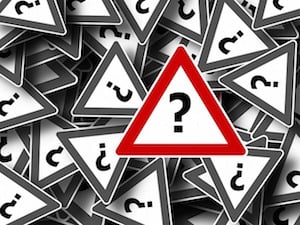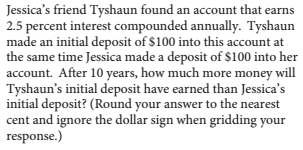
SAT Math questions often hit you with a lot of jargon. Some types of questions are prone to being pretty wordy, and many problems just don't make sense—they simply don't click in your brain.
Well, this state of affairs simply will not do. There's got to be a better way of hammering away at these problems. And, lo and behold, the post that follows has arrived to illuminate this path.
This article will walk you through how to figure out what an SAT Math question is really getting at—what it's truly asking under all that banter.
The SAT Math Question Method
This process applies to all types of math problems, from word problems to algebra problems to geometry problems (and all the rest of it).
The point of this procedure is to find out what the problem is really asking so you can avoid solving for the wrong variable or answering the wrong question.
A lot of it comes down to staying calm and returning to the information you know. Panicking won't help you, and you can always build off of the information that you understand.
Step 1: Give the Problem a Fair, Level-Headed Read
The point here is to assess, calmly, where you are with the problem. Some problems are easy to understand, and some are not, but you won't know until you do some reading.
Take a look at this question:

Now, depending on how handy you are with systems of equations, this might look like an easy problem or a harder problem. The question, though, is pretty clear: "What is the value of x?" That's what this question is asking at its very core.
Not all questions will be that direct:


This question has so many words that it's pretty easy to get lost in the jumble of what it's trying to say. At least, though, if we've read the problem, we know something about its general topic and we know to be very careful as we identify what it's asking. At this point, it may seem unclear: do we want Jessica's initial deposit? Or how much money Jessica has at the end? Or else Tyshaun? The answer is none of the above, as it turns out—read on to see why.

At least Jessica and Tyshaun have wisely invested their money instead of gambling it away.
Step 2: Find Your Given Information and Your Question or Command
Question and command terms give you crucial information about what you want to find.
In the question involving Jessica and Tyshaun, I see the words, "how much (more)." That's a huge clue to tell you what you're looking for: you want to know, in the test's words, "After 10 years, how much more money will Tyshaun's initial deposit have earned than Jessica's initial deposit?"
In this example, "how (much)" is easily identified as part of a question, but be on the lookout for non-question command terms, like find, identify, or determine. These, along with traditional question words like who/what/where/when/why, are key to understanding what the problem wants you to do or to answer.
Quantities are also relatively easy-to-identify pieces of given information. With Jessica and Tyshaun, I see quantities $100, 2%, 2.5%, and 10 years. Don't skimp out on those units! The number 10 isn't much help unless I know we're talking about years.
Labels are important, too. For instance, I see that Jessica and Tyshaun are earning "interest compounded annually."
All this information will help you solve the problem.
Not everything in every problem will help, though, so be sure to eliminate anything that seems extraneous at this point. There's not a whole ton of slack when it comes to Jessica and Tyshaun; all of that information really does pertain to the problem. Take a look at this problem, though:

We don't really care that this is a storage silo being used by a dairy farmer. We can cut straight to "right circular cylinder" and go from there.
Step 3: Take a Look at the Answers
If the question is multiple choice, see how the answers differ. What changes from one to another? Is it the quantities involved? The arrangement of variables? The units? Check to see what stays the same and what doesn't. That'll give you some hints as to what to pay attention to.
Ask yourself, what are these answer choices answering, exactly? That should be a good indication where, generally, you should be looking—eliminate answers that don't answer what the question asked. Or, if they all answer the same question, that's a strong indicator of what question you should be examining.
Hints may come from the units. The question, "How much milk does the dairy farm produce in a month?" would never been answered with a quantity of miles or cows. Gallons, maybe. Liters, maybe. But not kilometers or degrees.

Why isn't "I don't know" a possible answer on the SAT? I mean, it's a true statement, right?
Step 4: Rephrase the Question in a Way That Makes Sense to You
You've picked out the interesting points in the problem. You've isolated the question/command. You've considered what the answers have to say.
Now, bring everything together and try to express it in your own words. With Jessica and Tyshaun, I might say, "How much more money does Tyshaun earn in 10 years than Jessica?" Your version might sound a little different—that's fine, as long as we're working off of the same concept.
More Helpful Tips for Understanding SAT Math Problems
What follows is a smattering of other principles you can apply to math problems that are giving you trouble. Apply them often.
#1: Remember There Are a Ton of Ways to Rephrase the Same Information
You can word anything about a million different ways, switching from verbal to numeric and back again. Know which methods of expression jive best with you; are you more about the words or the symbols (and so on)?
#2: Take Things One Step at a Time
Remember that facts often flow from each other, one following another. You may not be given the information you need to find the answer directly, but you'll be given the information you need to find the information you need to find the answer.
If you're not sure, just take the next step you know how to take given what you know; it might lead somewhere!
#3: The Test-Makers Must Give You Enough Information
Again, you may need to take several steps to reach the answer, but, unless there's an answer choice which specifies that not enough information was given, there has to be enough there to find an answer.
Line up all the information you've been given and ask, what bit of information is missing? And how could I find it?

It's all about assembling clues.
#4: If Doesn't Mean Optional
When you see the word if, don't think of it as expressing an uncertain contingency: if means, "Be confident that it is so in the world of the SAT."
In the silo problem above, "If the volume of the silo is 72π cubic yards..." means, "The volume of the silo is 72π cubic yards. Period."
#5: Note Means "Pay Attention!"
When you see the word note at the end of a problem, it's time to take its message to heart. It might be a unit conversion, as in, "Note: 1 mile - 5,280 feet," or else some other such necessary information, but it will certainly be worth, well, noting.
Conclusion
A lot of solving strangely worded SAT Math problems comes down to staying calm and returning to what you know.
First, give the problem a fair read. Next, dissect what it's really telling you, and what of that might be useful. If you're stuck, try working backwards. Keep the big picture in mind.
Don't be afraid to tinker with problems—get that pencil moving, and do whatever looks possible: it's worth seeing what happens.
What's Next?
First of all, make your peace with the fact that you'll get stuck sometimes, and learn how to overcome it when it happens.
Then, get going on some practice problems, including a set of real whoppers assembled for you with care.
You may also be interested in paying some special attention to word problems, as these are often the toughest to interpret.
Want to improve your SAT score by 160 points?
Check out our best-in-class online SAT prep program. We guarantee your money back if you don't improve your SAT score by 160 points or more.
Our program is entirely online, and it customizes what you study to your strengths and weaknesses. If you liked this Math strategy guide, you'll love our program. Along with more detailed lessons, you'll get thousands of practice problems organized by individual skills so you learn most effectively. We'll also give you a step-by-step program to follow so you'll never be confused about what to study next.
Check out our 5-day free trial:
Have friends who also need help with test prep? Share this article!

Vero is a firsthand expert at standardized testing and the college application process. Though neither parent had graduated high school, and test prep was out of the question, she scored in the 99th percentile on both the SAT and ACT, taking each test only once. She attended Dartmouth, graduating as salutatorian of 2013. She later worked as a professional tutor. She has a great passion for the arts, especially theater.


































 Holly R.
Holly R.